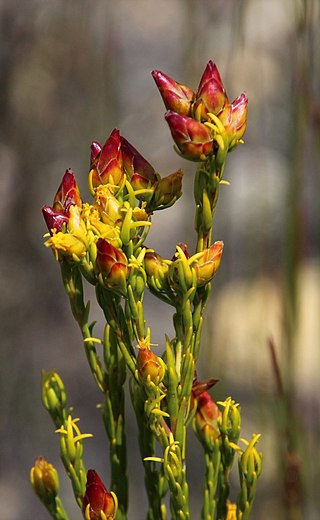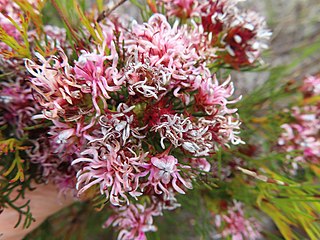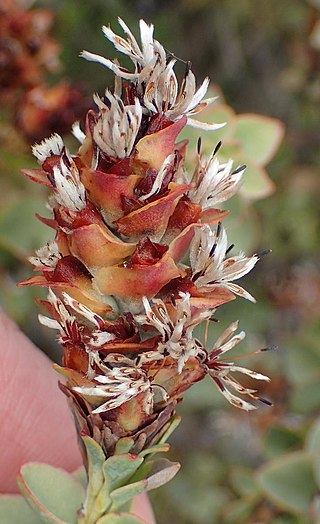
Paranomus is a genus of 18 species of flowering plants, commonly known as "sceptres", in the protea family. It is endemic to the Cape Floristic Region of South Africa.

Leucadendron olens, the yellow conebush, is a flower-bearing shrub that belongs to the genus Leucadendron and forms part of the fynbos. The plant is native to the Western Cape, South Africa.

Aulax pallasia, the needle-leaf featherbush, is a species of shrub in the genus Aulax. It is native to the Western Cape, South Africa.

Serruria bolusii, the Agulhas spiderhead, is a flower-bearing shrub that belongs to the family Proteaceae. It is part of the South African fynbos vegetation type. The plant is native to the Western Cape and is found in Elim hills and Soetanysberg. The shrub grows upright to 1.0 m tall and flowers from August to December.
Paranomus adiantifolius, the hairy-style sceptre, is a flower-bearing shrub that belongs to the genus Paranomus and forms part of the fynbos. The plant is native to the Western Cape, South Africa.

Paranomus sceptrum-gustavianus, the King Gustav's sceptre, is a flowering shrub that belongs to the genus Paranomus and forms part of the fynbos. The plant is native to the Western Cape, South Africa.

Paranomus dregei, the scented sceptre, is a flowering shrub belonging to the genus Paranomus. The plant is native to the Western Cape, South Africa.

Paranomus bracteolaris, the smooth-leaf tree sceptre or Bokkeveld sceptre, is a flower-bearing shrub that belongs to the genus Paranomus and forms part of the fynbos. The plant is native to the Western Cape and Northern Cape, South Africa.

Paranomus longicaulis, commonly known as exploding baked apple and woolly sceptre, is a flower-bearing shrub that belongs to the genus Paranomus and forms part of the fynbos. The plant is native to the Western Cape where it occurs on the eastern Langeberg from Garcia Pass to the Attakwaskloof.

Paranomus roodebergensis, also known as the honey-scented sceptre, is a flower-bearing shrub that belongs to the genus Paranomus and forms part of the fynbos. The plant is native to the Western Cape, South Africa.

Paranomus spathulatus, the Langeberg sceptre, is a flower-bearing shrub that belongs to the genus Paranomus and forms part of the fynbos. The plant is native to the Western Cape, South Africa.

Paranomus centaureoides, the Ladismith sceptre, is a flower-bearing shrub that belongs to the genus Paranomus and forms part of the fynbos. The plant is native to the Western Cape, South Africa.
Paranomus candicans, the powder sceptre, is a flower-bearing shrub that belongs to the genus Paranomus and forms part of the fynbos. The plant is native to the Western Cape, South Africa.
Paranomus lagopus, the rabbit-paw sceptre, is a flower-bearing shrub that belongs to the genus Paranomus and forms part of the fynbos. The plant is native to the Western Cape where it occurs in the Koue Bokkeveld Mountains, Groot-Winterhoek Mountains and Elandskloof Mountain.
Paranomus reflexus, the Van Staden's scepter, is a flower-bearing shrub that belongs to the family Proteaceae. It is part of the South African fynbos vegetation type. The plant is native to the Eastern Cape where it occurs on the Elandsberg and Van Stadensberg.
Paranomus capitatus, the fine-leaf sceptre, is a flower-bearing shrub that belongs to the genus Paranomus and forms part of the fynbos. The plant is native to the Western Cape where it occurs in the Du Toits Mountains south of Du Toitskloof Pass to the northern slopes of the Riviersonderend Mountains.

Paranomus dispersus, the long-head sceptre, is a flower-bearing shrub that belongs to the genus Paranomus and forms part of the fynbos. The plant is native to the Western Cape, South Africa.
Paranomus esterhuyseniae, the Kouga sceptre, is a flower-bearing shrub that belongs to the genus Paranomus and forms part of the fynbos. The plant is native to the Western Cape where it occurs in the Kouga Mountains and Outeniqua Mountains.

Paranomus tomentosus, the hairy-leaf tree sceptre, is a flower-bearing shrub that belongs to the genus Proteaceae. It is part of the South African fynbos vegetation type. The plant is native to the Western Cape, South Africa.
Paranomus spicatus, the Kogelberg sceptre, is a flower-bearing shrub that belongs to the genus Paranomus and forms part of the fynbos. The plant is native to the Western Cape where it occurs in the Hottentots Holland Mountains from Sir Lowry's Pass to Kogelberg.















